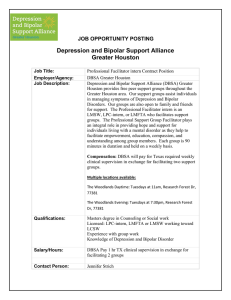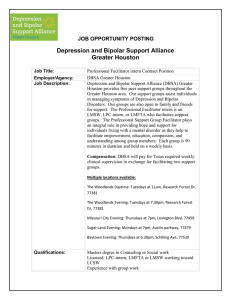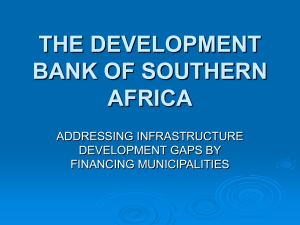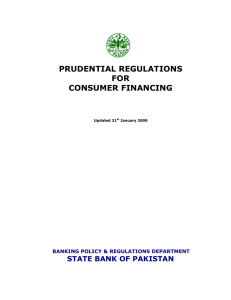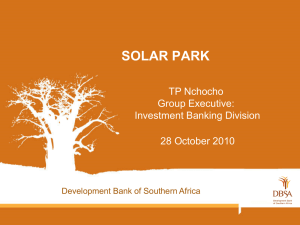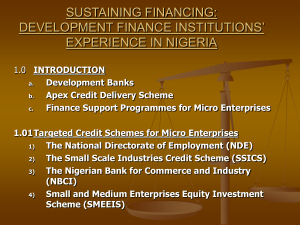Mr. Jose Garson, Consultant, BRED Gestion, France
advertisement
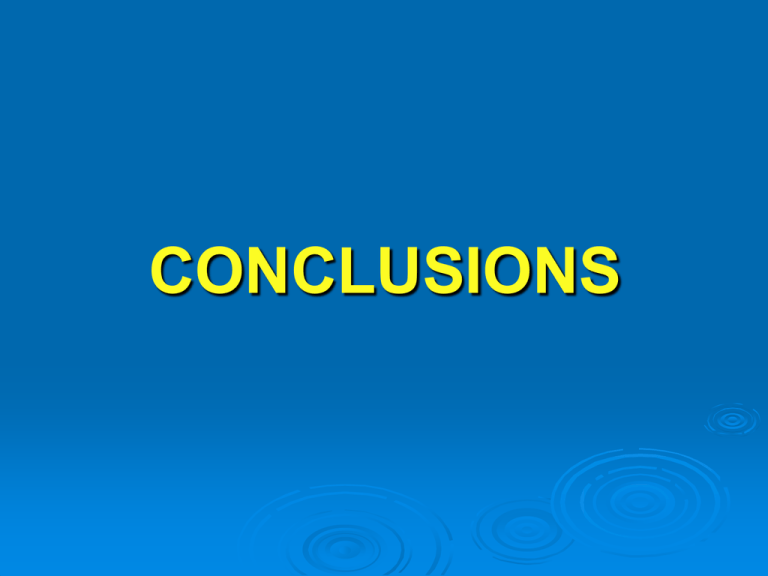
CONCLUSIONS Common Point # 1 FfD is a domain that deserves a specific attention today No institutional approach; functional approach (de B) Yet, institutions matters (see below) A holistic view of FfD, including position within financial sector must be taken No one-size-fits-all approach Must take into account that DFIs in Zone Franc are submitted to commercial-bank regulations (provisioning, usury rate, etc. (Comores, BNDA) Common Point # 2 FfD’s raison-d’être is to bring finance to specific clients/projects Market failures and vulnerable economic actors Local level • Local groups (BNDA) • Municipalities (DBSA) SMEs (ADB) Renewable Energies State failures Infrastructures (DBSA, BOAD, CDG) Common Point # 3 FfD is composed of a combination of variety of (i) specific financial instruments, (ii) specific non-financial instruments. Not just long-term finance Specific Financial Instruments Grants, Loans Leasing (DFCU, BOAD) Guarantees (BOAD) Equity participation (DBSA, Tunisia, BOAD, CDG) Underwriting (DBSA, BOAD, CDG) Arranging (DBSA, BOAD, CDG) Specific non-financial instruments Advorisy Services : “Development entails more than financing” (DBSA), Technical Assistance (DBSA, BOAD, DFCU) Capacity Building (DBSA) External Technical Services (BNDA) Common Point # 4 Resources are needed to build FfD financial instruments. Liquidity in banking systems is very important in Africa; not used for FfD (de B) Two opposite situations DFIs are banks • Relatively easy access to resources through deposits from clients and governments (BNDA, BGD) • Use of resources difficult because banking regulations (BNDA) DFIs are not banks • Resources are more difficult to mobilize (BOAD, DFCU, DBSA) • Use of mobilized resources left to DFIs because of lack of external regulations Concessional resources are needed Yes (BOAD, CDG) Not necessarily (DFCU) Common Point # 5 The organization supplying FfD (DFIs) must be a complex organization. It must be a Knowledge Organization DBSA : “We are an advanced knowledge-based organization” BOAD : études sur le coton, PME, HIV, etc. It must be an organization capable of playing multiple functions Financiers Partner (DBSA, BOAD, CDG) Adviser (DBSA, DFCU) It must be an organization knowing how to be a catalyst/facilitator (DBSA, BOAD, CDG) When DFIs are banks, they must Abide banking regulations (BNDA, BGD, Comores) • What can we do when regulators do not understand the constraints of FfD (BDEAC, BNDA) • Should not we revisit banking regulations to give more margin of action to FfD activities ? How can the two domains (commercial and developmental) be coordonated ? • By combining them in a single organization (BNDA, BGD) • By separating the two domains (DFCU) • By creating separate entities for each developmental activity (BGD). Common Point # 6 DFIs can be profitable. BOAD : “Nous n’avons pas vocation à faire des profits, mais dans la diversification et dans la conduite des actions nous générons des profits”. DFCU, BNDA DBSA : “making profit shields DFIs government interference”. Common Point # 7 (1/2) As organizations, DFIs must have a specific governance. Problem Capital of the DFIs will be predominately public Mission de service public (BNDA, BGD, DBSA, CDG, BOAD) Political pressure to promote regional integration (DBSA, BOAD) Market failures (private sector not interested) State failures (national budget cannot finance) Risks Interference from government (BOAD, Comores, ADB, Egypt) Civil servants managing FfD (Tunisia) Crowding out private sector (IBRD) Common Point # 7 (2/2) Proposed solutions DFIs must diversify its shareholders to bring counterweight to government (BOAD, BGD) DFIs must pay attention to the composition of their Board Board Members should be trained and made aware that they have a responsibility (DFCU) External personalities/independent persons will bring weight to Board (BGD) DFIs that are not banks should impose on themselves stringent rules Criteria of internal rules of some DFIs are more severe than banking regulations (SADCC) Pressure from outside actors is useful “Les marchés nous jugent” (BOAD) Ratings are crucial (SADCC, BOAD) Being profitable is best protection from government : see above (DBSA). Draft action proposals 1. Make an inventory of DFI success stories & lessons learnt 2. Organise sub-regional consultations 3. Organise exchange of DFI best practices and standards 4. Liaise with other fora on corporate governance (IBRD, OECD) 5. Organise a working group on regulations to work on DFI specificities
